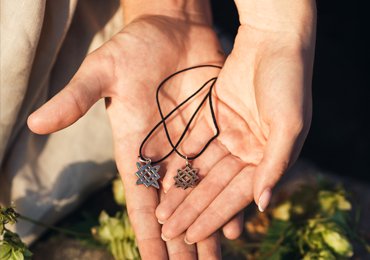Karma Kanda & The Essential Forms Of Puja
In the Vedas, there are 3 types of kandas viz. Karma kanda, jnana kanda and upasana kanda. Out of which, today we are going to discuss in detail about karma kanda. Where karma kanda is related to the execution of fruitive activities. It is referred to as sacrificial activities, which allows a person to attain a very fundamental level in his/her spiritual life. According to the Vedic principles, it follows a procedure of performing rituals that are generally associated with puja/anusthan performed by a pandit.
Theory Behind Karma Kanda
Karma Kanda can be performed both individually and with the help of a pandit. If done individually, which is referred to as the diluted form by a common man, then it has to be executed appropriately/in a correct manner. Also, it is a continuous/long-lived process, so if done wrongly any bit, it might cause damage to the person practising it (Though karma kanda won’t cause harm).
Wearing a toe ring
It doesn’t just signify that a woman is married yet the toe ring presses a particular nerve from the second toe which connects to the uterus and passes to the heart.
Also, it helps in regulating the blood flow while regularizing the menstrual cycle.
Mostly silver material toe rings are preferred as it absorbs polar energies from the earth and passes it on to the body.
Puja executed by a Pandit:
This can be related to a simplified example of the Deepawali festival, where the pandit conducts the puja and performs the shodash upchar of the goddess. Where the pandit seeks Lord Ganesha’s blessings to ensure that he doesn’t face any vighana (hurdle) during this process. Then he incorporates avahan, snan (bath), vastra (clothes), tika, gandh (perfume), prasad, hand cleansing, supari, dakshina, aarti (prayer), etc. to perform the same.
When the puja is done on an individual level:
Here, Lord Ganesha stands to be the presiding deity of the Muladhara chakra, where the individual has to perform this ritual on his own. For this, he/she needs to meditate on Muladhara with a specific mantra. In order to invoke (do avahan of), Devi one has to place it at a specific place in the body through a process that is known as Nyasa in tantra. So, if sacred oblation/havan is performed then it has to be executed around the Manipur chakra that has eternal fire.
Main Forms of Puia
There are two forms of puja, which can be opted based on one’s feasibility and available time/resources. Where Shodashopachara Puja is considered as the long-form version, consisting of 16 steps. However, on the other hand, Panchopachara Puja is considered to be a simplified version of Shodashopchara Puja. As it entails just 5 steps to perform this form of Puja. Just always remember that whenever you perform any form of puja, the most ideal direction is facing the east-west direction.
An important consideration before performing the puja:
Before performing any form of puja/prayer/spiritual practice, it is necessary to light a lamp/diya. It is ideally best if it’s done with a pure cow ghee lamp. As Agni deva’s presence is indispensable before conducting any spiritual practice. And fire/Agni not only purifies the atmosphere but as per Vedic pujas, Agni deva is believed to be a witness of one’s deeds/karma. In addition to this, it also purifies one’s karma ensuring that whatever he/she practises, is executed properly.
The science behind lighting the lamp with cow ghee:
Ghee lamp has relatively more capacity to attract the sattvik vibrations present in the ambience in comparison to an oil lamp. When cow’s ghee is put in the fire, its smoke lessens the effect of radiations present in the atmosphere (to a great extent.)
Also, it doesn’t emit any harmful oxides, which is toxic/dangerous for the sadhak’s inhale. Instead, it purifies the dust, allergies and infections, etc from the ambience.
Now, let’s understand each form:
- Shodashopachara Fia The long form Puja
The puja service includes:
1) Dhyana: mediation & invocation of the deity.
2) Aavaanhana: inviting the deity to the place of worship Chant: Om Sri [Deity name] avahanam samarpayami.
3) Asana: welcoming & offering a seat to the deity Chant: Om Sri [Deity name]
ãsanam samarpayâmi.
4) Paadya: washing the feet of deity using holy water.
5) Arghya: requesting & offering water to the deity for rinsing hands along with mouth.
6) Aachamana: offering drinking water to the deity Chant: Om Sri [Deity name] pâdyam ärghyam achamaniyam samarpay§mi.
7) Snaana: bathing the deity with holy samagri Chant: Om Sri [Deity name] snânam samarpayami.
8) Vasthra: dressing up the deity Chant: Om Sri [Deity name] vastram samarpayāmi.
9) Yagnopaveetha: offering a clean & sacred thread to the deity Chant: Om Sri [Deity name] yagnopaveetam samarpayàmi.
10) Gandha: applying fragrant & fresh sandalwood paste on the deity Chant: Om Sri [Deity name] chandanam samarpayāmi, Om Sri [Deity name] sindoor tilakam samarpayami, Om Sri [Deity name] haldiyam samarpayami, Om Sri [Deity name] vibhooti samarpayâmi.
11) Pushpa: offering fresh flowers to the deity Chant: Om Sri [Deity name] pushpam samarpayāmi.
12) Dhoopa: burning incense sticks/smoke, which is spread across the altar Chant:
Om Sri [Deity name] dhoopam samarpayami.
13) Deepa: lightening a ghee or oil lamp in front of the deity Chant: Om Sri [Deity name] deepam samarpayâmi.
14) Naivedya: offering food to the deity Chant: Om Sri [Deity name] naivedyam samarpayâmi.
15) Taambula: offering betel nut & leaves to the deity Chant: Om Sri [Deity name] tambulam samarpayāmi.
16) Pradakshina & Namaskara: circle on foot ritualistically in the altar & bid farewell to the deity Chant: Om Sri [Deity name] pradakshina samarpayāmi; Om Sri [Deity name] namaskäram samarpayāmi
During the closing mantra, the devotee chants the following:
kayena vaca manase indriyairva buddhy ätmana vã prakrteh svabhävāt karomi yad yat sakalam parasmai narayanãyeti samarpayāmi This means: Whatever I do with my Body, Speech, Mind/Senses, Intellect, Feelings or unconsciously through my natural tendencies. I do it selflessly for others and surrender it all at the Lotus Feet of Divine. • Panchopchar Fuja [u u’: The short form Puja This puja is performed in the morning or 1.5 hours before the sunset, which is also known as the pradosh period. Or even during the evening time of puja. As the name suggests it is composed of 5 items that are used in this simple puja vidhi.
The Panchopachar puja samagri/items include:
1) Sugandham/Akshatam: Rice.
2) Pushpam: Dhoop or incense.
3) Dhoopam: Diya/deep or lamp/light.
4) Deepam: Pushpa i.e. flowers
5) Naivedyam: Usually consists of sweet/fruits or simple rice preparation.
Steps to perform this puja:
1) Requires cleaning of the house/area of puja.
2) After this, one needs to take bath and purify himself/herself.
3) Now, offer prayers to Lord Ganesha.
4) The deity to whom puja is offered should be placed.
5) Keep a Kalash, which should be filled with water, then put a coin, rice and til inside. If you wish to close the Kalash top, then cover it with mango leaves and coconut.
6) Light the lamp using cow ghee or you can also use oil too.
7) Dhoop or incense can be offered to the deity.
8) Akshat rice and chandan, sindhoor or bhasma should be offered.
9) Now, offer flowers along with some sweets or fruit.
10) Worship/offer prayer to the deity.
11) Ensure that you have a peaceful ambience around when you sit in a meditation pose in this step.
12) Chant the mantra/pray.
Avoid performing puja during any of these states:
- Without a bath/intoxicated state.
- During the 10-day sutak/soyar period.
- Where there is an absence of a separate deity temple/mandir/room in the house and a lady is on her menstruation.
Importance and benefits that can be gained out of these puja forms:
- The Deity Principle: If the sanskars are performed with bhav, the Idol enhances.
- To obtain the Deity’s grace: Puja pleases the deity and it becomes easier to obtain the grace.
- Divine consciousness in the worshipper improves: While performing puja, the worshipper imbibes the deity principle, which lessens the proportion of raja-tama components in an individual. This aids in the growth of chaitanya.
- Impact of sattvik waves: These waves absorbed from the puja benefit in performing various activities all day through.
- The environment gets purified: Puja helps out in boosting the purity of the environment.
This blog’s aim was to detail out the importance of puja vidhi. So, among the various puja forms i.e. manaspuja, parapuja, panchopachar and shodashopchar puja. We discussed about the 2 main forms i.e. panchopachar and shodashopachar puja.
These forms of puja teach an individual to abide by dharma in a ritualistic manner.
This has a strong connection with the scientific depth of the upachars as per the Hindu dharma. May you attain the most in life, through inculcating the habit of performing regular puja/archana for the deity.v
Suggested Blogs

Planets/Upgrah
Surya is the soul of all (Aatman).Chandrama is the mind (Man-o-gati).Mangal is one’s strength(bestower of power….

Jagadamba Path
Devi Durga is known as Goddess of Power. Her presence is all pervading. She is the souce of all creation,righteousness and she is the….

Vastu Shastra
We human beins are always surrounded by vibration of energy around us.considering this fact,most of us spend our time in a building….
